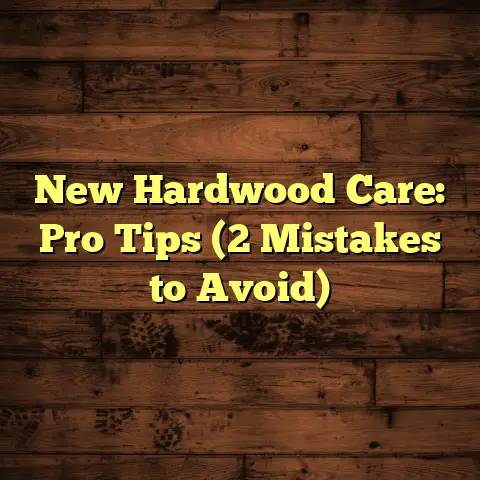Water Under Floorboards? (1 Urgent Inspection!)
And let me tell you, there’s one issue that sends shivers down my spine more than almost anything else: water under floorboards.
According to the Insurance Information Institute, water damage and freezing accounted for more than 20% of all homeowners’ insurance claims in the United States in 2020.
That’s a huge number!
And it underscores just how common and serious water-related issues are in our homes.
Trust me, folks, this isn’t something you want to ignore.
Understanding the Problem
So, what exactly are we talking about when we say “water under floorboards?”
Well, it’s pretty much what it sounds like: water accumulating in the space beneath your flooring.
This can be in a crawl space, on a concrete slab, or even between layers of subflooring.
The sources? Oh, they’re numerous and often sneaky.
We’re talking plumbing leaks, flooding (natural disasters), condensation, high humidity, and even groundwater seepage.
What are the warning signs?
- Changes in floor texture (warping, cupping).
- Buckling or lifting floorboards.
- Visible mold or mildew growth.
- A musty or damp smell.
- Staining or discoloration on the flooring.
- Soft spots or bouncy areas.
If you spot any of these, it’s time to investigate!
Why is it urgent?
Because water damage doesn’t just disappear.
It festers, it spreads, and it causes serious problems.
We’re talking structural damage, mold growth, health risks, and hefty repair bills.
Causes of Water Under Floorboards
Let’s dive into some of the common culprits behind this watery woe:
1. Leaky Pipes or Plumbing Failures
This is probably the most common offender.
A pinhole leak in a copper pipe, a loose fitting under a sink, or a cracked toilet flange can all slowly drip water into the subfloor.
Example: I once saw a homeowner who ignored a small stain around their toilet for months.
Turns out, the wax ring had failed, and water was seeping into the subfloor every time they flushed.
By the time they called me, the entire bathroom floor had to be ripped out and replaced!
2. Flooding from Heavy Rain or Natural Disasters
This one’s pretty self-explanatory.
A severe storm, a burst river, or even a leaky roof can send water cascading into your home.
Example: I worked on a house after a major hurricane.
The floodwaters had completely inundated the crawl space, soaking the floor joists and subfloor.
The mold growth was so bad that the entire house had to be professionally remediated.
3. Groundwater Issues, Including Poor Drainage
If your home is built on a poorly drained site, groundwater can seep up through the foundation and into the crawl space.
This is especially common in areas with high water tables or clay soil.
Example: I inspected a house where the gutters were clogged with leaves.
During heavy rains, the water would overflow and pool around the foundation, eventually seeping into the crawl space.
4. Condensation and Humidity Issues
In humid climates, condensation can form on cold surfaces, like pipes or concrete floors.
This moisture can then seep into the subfloor and lead to mold growth.
Example: I’ve seen basements with high humidity levels where condensation forms on the concrete slab.
Over time, this moisture can wick up into the wood framing and cause rot.
Think of it this way: Imagine leaving a glass of ice water on a table.
The condensation that forms on the outside of the glass is similar to what can happen under your floorboards.
Immediate Actions to Take
Okay, so you suspect you have water under your floorboards.
Don’t panic!
Here’s what you should do right away:
-
Visual Inspection: Get down on your hands and knees (or hire a professional). Look for the warning signs we talked about earlier like discoloration, mold, or warping.
-
Check for Leaks: Inspect all plumbing fixtures, appliances, and pipes in the area. Look for drips, puddles, or signs of corrosion.
-
Identify Visible Mold: If you see mold or mildew, don’t touch it! Mold can be harmful to your health.
-
Call a Professional: This is the most important step. A qualified professional can accurately assess the extent of the damage and recommend the appropriate course of action.
Why is contacting a professional so crucial?
Because they have the tools and expertise to find hidden leaks, assess structural damage, and identify potential health hazards.
Trying to DIY this problem can often make things worse.
The Inspection Process
So, what can you expect when you call a professional for an inspection?
Here’s a breakdown of what usually happens:
-
Initial Consultation: The inspector will ask you questions about the problem, such as when you first noticed the signs, where you suspect the water is coming from, and any recent plumbing work you’ve had done.
-
Visual Inspection: The inspector will thoroughly examine the affected area, looking for signs of water damage, mold growth, and structural problems.
-
Moisture Meter Readings: Moisture meters are used to measure the moisture content of the flooring, subfloor, and surrounding materials. This helps the inspector determine the extent of the water damage.
Material Acceptable Moisture Content Hardwood Floors 6-8% Softwood Floors 12-15% Subfloor <12% -
Thermal Imaging: Thermal cameras can detect temperature differences, which can help identify hidden leaks behind walls or under floors.
-
Crawl Space Inspection: If your home has a crawl space, the inspector will likely want to take a look under there. This is a common area for water to accumulate.
-
Basement Inspection: Similarly, if you have a basement, the inspector will check for signs of water intrusion.
-
Air Quality Testing: If mold is present, the inspector may recommend air quality testing to determine the type and concentration of mold spores in the air.
-
Structural Assessment: If the water damage is severe, the inspector may recommend a structural assessment to determine if the floor joists or other structural components have been weakened.
-
Report and Recommendations: After the inspection, the inspector will provide you with a detailed report outlining their findings, along with recommendations for repair or remediation.
Consequences of Ignoring the Problem
Okay, let’s get real.
What happens if you just ignore that little bit of water under your floorboards?
Here’s a glimpse into the potential nightmare:
-
Structural Damage: Water can weaken wood, causing it to rot and decay. This can compromise the structural integrity of your home, leading to sagging floors, cracked walls, and even foundation problems.
-
Mold and Mildew Growth: Mold thrives in damp, dark environments. Water under your floorboards creates the perfect breeding ground for mold, which can trigger allergies, asthma, and other respiratory problems.
-
Health Risks: Mold exposure can cause a variety of health problems, including coughing, sneezing, runny nose, skin rashes, and headaches. In severe cases, mold can even lead to serious lung infections.
-
Increased Costs: The longer you wait to address the problem, the more extensive and expensive the repairs will be. What starts as a small leak can quickly turn into a major renovation project.
I remember one case where a homeowner ignored a slow leak under their kitchen sink for years.
By the time they called me, the entire kitchen floor had to be ripped out, the subfloor had to be replaced, and the walls had to be treated for mold.
The total cost? Over $10,000!
Long-Term Solutions and Prevention
While the focus here is on urgent inspection, it’s worth touching on long-term prevention:
-
Regular Plumbing Maintenance: Have your plumbing system inspected annually to identify and repair any potential leaks.
-
Proper Drainage: Make sure your gutters are clean and that your yard slopes away from your foundation.
-
Moisture Control: Use dehumidifiers in damp areas, like basements and crawl spaces. Ensure proper ventilation in bathrooms and kitchens.
-
Water-Resistant Flooring: Consider using water-resistant flooring materials, like tile or vinyl, in areas prone to moisture.
-
Sump Pump: If you live in an area with a high water table, consider installing a sump pump to remove excess water from your basement or crawl space.
Conclusion
Water under floorboards is a serious problem that should never be ignored.
The consequences of neglecting this issue can be devastating, ranging from structural damage to health risks and costly repairs.
If you suspect you have water under your floorboards, don’t hesitate to take action.
Contact a qualified professional for an inspection to assess the extent of the damage and recommend the appropriate course of action.
Taking immediate action will not only protect your home and your health but also give you peace of mind knowing that you’ve done everything you can to address the problem.
Call to Action
Don’t wait until it’s too late!
If you suspect water under your floorboards, contact a qualified professional for an inspection today.
Protect your home, protect your health, and gain peace of mind.
Your home will thank you for it!





